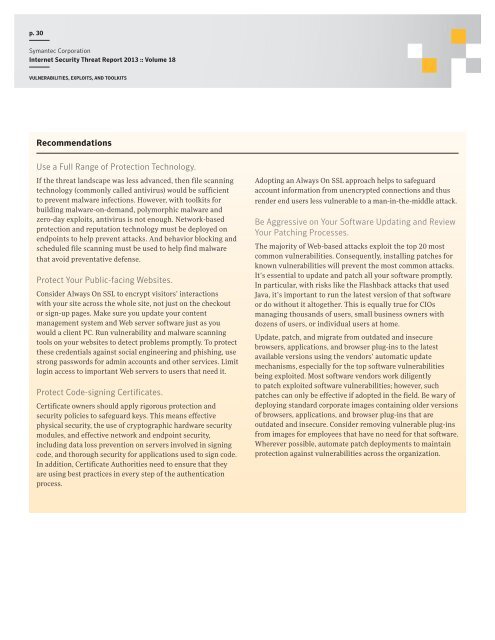internet security tHreAt rePOrt GOVernMent 2013
internet security tHreAt rePOrt GOVernMent 2013
internet security tHreAt rePOrt GOVernMent 2013
You also want an ePaper? Increase the reach of your titles
YUMPU automatically turns print PDFs into web optimized ePapers that Google loves.
p. 30<br />
Symantec Corporation<br />
Internet Security Threat Report <strong>2013</strong> :: Volume 18<br />
VULNERabILITIES, ExPLOITS, aNd TOOLkITS<br />
Recommendations<br />
Use a Full Range of Protection Technology.<br />
If the threat landscape was less advanced, then file scanning<br />
technology (commonly called antivirus) would be sufficient<br />
to prevent malware infections. However, with toolkits for<br />
building malware-on-demand, polymorphic malware and<br />
zero-day exploits, antivirus is not enough. Network-based<br />
protection and reputation technology must be deployed on<br />
endpoints to help prevent attacks. And behavior blocking and<br />
scheduled file scanning must be used to help find malware<br />
that avoid preventative defense.<br />
Protect Your Public-facing Websites.<br />
Consider Always On SSL to encrypt visitors’ interactions<br />
with your site across the whole site, not just on the checkout<br />
or sign-up pages. Make sure you update your content<br />
management system and Web server software just as you<br />
would a client PC. Run vulnerability and malware scanning<br />
tools on your websites to detect problems promptly. To protect<br />
these credentials against social engineering and phishing, use<br />
strong passwords for admin accounts and other services. Limit<br />
login access to important Web servers to users that need it.<br />
Protect Code-signing Certificates.<br />
Certificate owners should apply rigorous protection and<br />
<strong>security</strong> policies to safeguard keys. This means effective<br />
physical <strong>security</strong>, the use of cryptographic hardware <strong>security</strong><br />
modules, and effective network and endpoint <strong>security</strong>,<br />
including data loss prevention on servers involved in signing<br />
code, and thorough <strong>security</strong> for applications used to sign code.<br />
In addition, Certificate Authorities need to ensure that they<br />
are using best practices in every step of the authentication<br />
process.<br />
Adopting an Always On SSL approach helps to safeguard<br />
account information from unencrypted connections and thus<br />
render end users less vulnerable to a man-in-the-middle attack.<br />
Be Aggressive on Your Software Updating and Review<br />
Your Patching Processes.<br />
The majority of Web-based attacks exploit the top 20 most<br />
common vulnerabilities. Consequently, installing patches for<br />
known vulnerabilities will prevent the most common attacks.<br />
It’s essential to update and patch all your software promptly.<br />
In particular, with risks like the Flashback attacks that used<br />
Java, it’s important to run the latest version of that software<br />
or do without it altogether. This is equally true for CIOs<br />
managing thousands of users, small business owners with<br />
dozens of users, or individual users at home.<br />
Update, patch, and migrate from outdated and insecure<br />
browsers, applications, and browser plug-ins to the latest<br />
available versions using the vendors’ automatic update<br />
mechanisms, especially for the top software vulnerabilities<br />
being exploited. Most software vendors work diligently<br />
to patch exploited software vulnerabilities; however, such<br />
patches can only be effective if adopted in the field. Be wary of<br />
deploying standard corporate images containing older versions<br />
of browsers, applications, and browser plug-ins that are<br />
outdated and insecure. Consider removing vulnerable plug-ins<br />
from images for employees that have no need for that software.<br />
Wherever possible, automate patch deployments to maintain<br />
protection against vulnerabilities across the organization.


